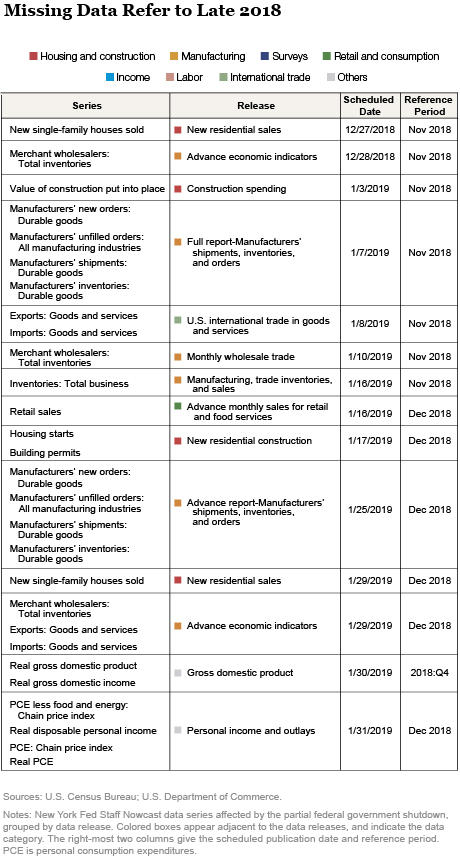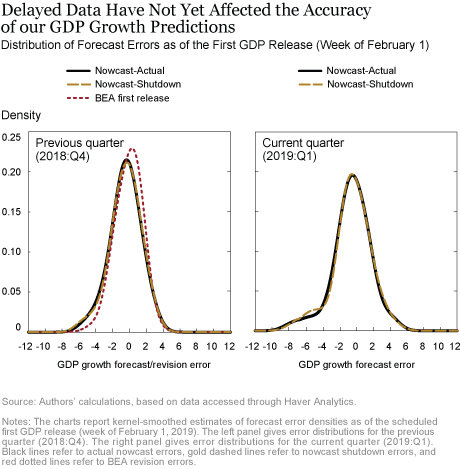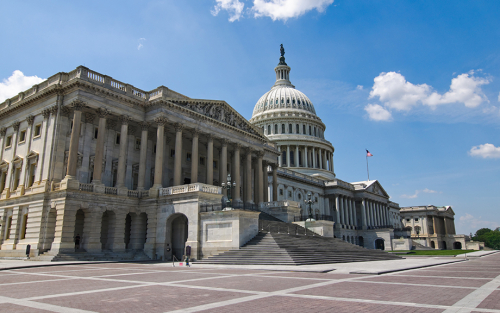The recent partial shutdown of the federal government has disrupted publication schedules for many U.S. Census Bureau and Bureau of Economic Analysis (BEA) data releases. Most notably, the release of GDP for the fourth quarter of 2018—originally scheduled for January 30—has been postponed indefinitely. Even without the full slate of Census Bureau and BEA releases, forecasters have continued to make predictions for 2018:Q4 GDP growth; as of February 1, the New York Fed Staff Nowcast stands at 2.6 percent, the Atlanta Fed’s GDPNow stands at 2.5 percent, and the Blue Chip Financial Forecasts estimate stands at 2.6 percent. How accurate are these predictions for 2018:Q4 relative to the BEA’s first estimate? Have the missing data jeopardized the accuracy of predictions for 2019:Q1? The New York Fed Staff Nowcast provides a lens through which to answer these questions, thanks to its entirely automated design and its ability to mimic judgmental forecasters’ processing of incoming data. Using real‑time historic data, we can assess the importance of missing releases by simulating similar dataflow disruptions for past quarters.
We find that these data missing as a result of the government shutdown have not yet affected the accuracy of our predictions for real GDP growth in both the previous quarter (2018:Q4) and current quarter (2019:Q1). Indeed, even without these data releases, our prediction is generally as reliable as the first official estimate in predicting “true” output growth (as measured by the latest revised estimate of real GDP growth); thus, the delayed publication of the BEA’s first estimate of 2018:Q4 GDP growth does not represent a major loss of information. Data releases prior to and those unaffected by the government shutdown provide ample information for our automated nowcasting model to make an accurate prediction. However, if additional disruptions to the data flow were to occur in mid-February and beyond, the absence of key hard data would likely reduce the accuracy of the nowcast for the current quarter (2019:Q1).
Before getting into details, a caveat is in order. Our analysis here focuses only on the effects of delayed data releases on our ability to track economic conditions using the New York Fed Staff Nowcast, not on the potential direct effects of the shutdown on economic activity.
Which Data Releases Have Been Delayed?
The table below lists the data series used in our model for which the publication of new or revised estimates has been delayed owing to the shutdown. Nineteen of our model’s thirty-seven total input variables are affected, including all variables in the “retail and consumption” and “housing and construction” categories. Even when these data are released as regularly scheduled, they are all published weeks after the end of the time period to which they refer. For example, the first estimate of retail sales in December is provided in the Advance Monthly Retail Trade Report normally published by the Census Bureau in mid-January. The right-most column of the table lists the reference period for each delayed release, showing that all of the missing data originally scheduled for publication in January refer to economic activity in the final months of 2018.

Assessing the Importance of the Missing Data
To assess how these dataflow disruptions affect the accuracy of our GDP growth predictions, we carry out a counterfactual exercise. We run sixty‑four scenarios—one for each quarter from 2002:Q1 to 2017:Q4—assuming that the Census Bureau and the BEA stop publishing new data roughly one week before the start of the quarter. We then make daily real‑time forecasts for real GDP growth in the previous and current quarters, using exactly the data that would have been available if these two agencies remained closed. For example, we make daily forecasts throughout the first quarter of 2017 for growth in both 2016:Q4 and 2017:Q1, assuming that historical data for the series in the above table are unchanged since late December 2016. By comparing these counterfactual forecasts with those obtained using all of the data available at the time, we can evaluate the impact of the recent publication delays on the accuracy of the current New York Fed Staff Nowcast predictions. However, we cannot address the fact that released data would have differed in the event of actual shutdowns.
For all quarters in the evaluation sample, the chart below reports errors of the real-time nowcast, the government-shutdown scenario, and the first official GDP release, all relative to the latest GDP data. We compare with the latest available data since estimates are continuously revised to incorporate new source data and methodological changes. The x‑axis refers to the point in the quarter when the nowcasts were made, measured in the number of weeks before the first official GDP release. The red triangles report the revision error of the first release, with bars indicating the 16th and 84th percentiles of their empirical distribution. Nowcast errors are reported by color: black errors for the actual nowcast and gold errors for the government-shutdown counterfactual. Shaded areas show the 16th and 84th percentiles of the empirical distributions of the respective partitions. The start of the gold band marks the beginning of the government-shutdown scenario.
Inspecting the shaded bands, the error distributions for 2018:Q4 GDP growth predictions are nearly identical for the actual nowcast and the government-shutdown scenario. From the model’s perspective, most of the important data for predicting growth in a given quarter arrive by the end of that quarter. Therefore, even if the data scheduled for release in January were published on time, it is unlikely that the new information contained in these releases would have considerably changed our 2018:Q4 forecast.

The error distributions exhibit characteristics of a good forecast. The bands narrow in width as time goes on, indicating on average a more accurate prediction of GDP growth over the nowcasting period as more information about the economy is released. Finally, at the end of the nowcast updating period, the bands are similar to the error bars for the first GDP release, indicating that the uncertainty surrounding the final nowcast made for each quarter is similar to that of the BEA’s first estimate in predicting the true value of aggregate output growth in the economy.
Better illustrating these points, the next panel chart provides smoothed estimates of the errors reported above for both quarters at the time of the normally scheduled first release of GDP, which currently corresponds to January 30, 2019. Black refers to the actual nowcast errors, gold refers to counterfactual nowcast errors, and red refers to the BEA revision error. The black and gold error distributions in the left panel are nearly identical, showing that the delay of these data releases would not have substantially affected uncertainty around predictions for the previous quarter. Additionally, both of these distributions are broadly similar to the red distribution, indicating that there is comparable uncertainty around the BEA’s first estimate and our prediction at the same date. The differences arise primarily for large negative errors, which are more likely to occur for the nowcast than for the BEA first estimate.

Similarly, the right panel of the chart provides the distributions of the smoothed nowcast errors, now for 2019:Q1. The delay of January’s scheduled data releases also appears to have had little impact on the uncertainty around our model’s latest nowcast for 2019:Q1 GDP growth, since the distributions of the actual and counterfactual errors are similar. As discussed above, the missing hard data that were scheduled for January publication all referred to economic activity in late 2018 rather than the present. In the first half of a quarter, business sentiment surveys (or “soft” data) and labor market indicators tend to move the GDP growth nowcast more than hard data, since they provide the earliest readings on economic activity in the current quarter. Since the publication of these data has not been affected by the government shutdown, we expect the accuracy of our 2019:Q1 nowcast to be broadly unaffected by previous dataflow disruptions.
Summing Up
Overall, delays in the publication of macroeconomic data throughout January have had little impact on our ability to accurately monitor economic conditions in real time. However, additional publication delays in mid-February and beyond would prevent the release of important hard data for the early months of 2019, increasing uncertainty around our 2019:Q1 GDP growth forecasts.
Disclaimer
The views expressed in this post are those of the authors and do not necessarily reflect the position of the Federal Reserve Bank of New York or the Federal Reserve System. Any errors or omissions are the responsibility of the authors.
 Patrick Adams is a senior research analyst in the Federal Reserve Bank of New York’s Research and Statistics Group.
Patrick Adams is a senior research analyst in the Federal Reserve Bank of New York’s Research and Statistics Group.
 Domenico Giannone is an assistant vice president in the Research and Statistics Group.
Domenico Giannone is an assistant vice president in the Research and Statistics Group.
 Eric Qian is a senior research analyst in the Research and Statistics Group.
Eric Qian is a senior research analyst in the Research and Statistics Group.
 Argia M. Sbordone is a vice president in the Research and Statistics Group.
Argia M. Sbordone is a vice president in the Research and Statistics Group.
How to cite this blog post:
Patrick Adams, Domenico Giannone, Eric Qian, and Argia M. Sbordone, “Monitoring Economic Conditions during a Government Shutdown,” Federal Reserve Bank of New York Liberty Street Economics (blog), February 5, 2019, https://libertystreeteconomics.newyorkfed.org/2019/02/monitoring-economic-conditions-during-a-government-shutdown.htm.











 RSS Feed
RSS Feed Follow Liberty Street Economics
Follow Liberty Street Economics